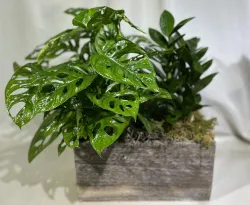Monstera plants, or more specifically their leaves, have become somewhat of a trend in recent pop culture. You can find everything from phone cases and jewelry to bed sheets and shower curtains adorned with the large tropical leaves of the cutely nicknamed “Swiss cheese plant.” Monsteras are a wonderfully resilient plant and are perfect for even the newest plant enthusiast.
Known for the iconic holes and splits in its large tropical leaves, monsteras are native to Mexico and can be found in other tropical locations like Hawaii and Florida. As a member of the araceae family, monstera plants are close relatives to both peace lilies and pothos plants. The plants can produce a cup-like bloom that resembles the blossom of its cousin, the peace lily. In the wild, the monstera plant can also produce fruit, however it is extremely rare indoors.
Monsteras will grow in a wide variety of light levels, but they do best in indirect, bright light. The more light these plants receive, the larger their leaves will grow and more of those distinct holes on the leaves will develop. The splits and holes are known as “fenestrations” and allow the plant to withstand even the strongest winds in the wild. Play around with the lighting in your house to help your monstera leaves develop. But be careful because direct light can even sunburn a tropical plant!
Monstera plants grow best in rich and nutrient-dense potting soil. Being a hardy houseplant, your monstera will forgive you if you miss watering once in a blue moon. However, make sure the plant has good drainage and try to aerate the soil often. When watering any houseplants, the soil naturally compacts, so by aerating and loosening the soil, water can reach the roots much quicker. If your monstera is looking a little sad, water it thoroughly and monitor the soil moisture before watering next.
Remember, monsteras are tropical plants. They thrive in warm and humid temperatures similar to its natural equatorial environment. But you don’t have to live in the jungle to enjoy these houseplants. Monsteras will tolerate regular household humidity — just make sure the air isn’t too dry. In the hot months, avoid direct AC from freezing your plant by sitting it in the shade outside since their growing season is spring and summer.
Every monstera plant is truly unique as the splits and holes of the tropical leaves are rarely alike. Not to mention the size and shape of its leaves can vary — even on the same plant! Ask us about including monstera leaves in your next arrangement or try your hand at tending this tropical plant in your own home.



